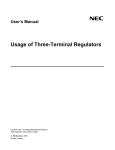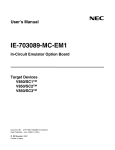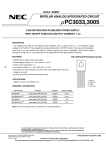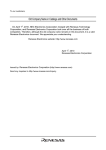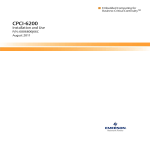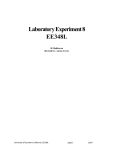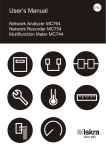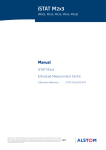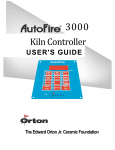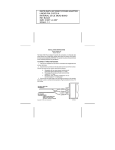Download Usage of Three-Terminal Regulators UM
Transcript
To our customers, Old Company Name in Catalogs and Other Documents On April 1st, 2010, NEC Electronics Corporation merged with Renesas Technology Corporation, and Renesas Electronics Corporation took over all the business of both companies. Therefore, although the old company name remains in this document, it is a valid Renesas Electronics document. We appreciate your understanding. Renesas Electronics website: http://www.renesas.com April 1st, 2010 Renesas Electronics Corporation Issued by: Renesas Electronics Corporation (http://www.renesas.com) Send any inquiries to http://www.renesas.com/inquiry. Notice 1. 2. 3. 4. 5. 6. 7. All information included in this document is current as of the date this document is issued. Such information, however, is subject to change without any prior notice. Before purchasing or using any Renesas Electronics products listed herein, please confirm the latest product information with a Renesas Electronics sales office. Also, please pay regular and careful attention to additional and different information to be disclosed by Renesas Electronics such as that disclosed through our website. Renesas Electronics does not assume any liability for infringement of patents, copyrights, or other intellectual property rights of third parties by or arising from the use of Renesas Electronics products or technical information described in this document. No license, express, implied or otherwise, is granted hereby under any patents, copyrights or other intellectual property rights of Renesas Electronics or others. You should not alter, modify, copy, or otherwise misappropriate any Renesas Electronics product, whether in whole or in part. Descriptions of circuits, software and other related information in this document are provided only to illustrate the operation of semiconductor products and application examples. You are fully responsible for the incorporation of these circuits, software, and information in the design of your equipment. Renesas Electronics assumes no responsibility for any losses incurred by you or third parties arising from the use of these circuits, software, or information. When exporting the products or technology described in this document, you should comply with the applicable export control laws and regulations and follow the procedures required by such laws and regulations. You should not use Renesas Electronics products or the technology described in this document for any purpose relating to military applications or use by the military, including but not limited to the development of weapons of mass destruction. Renesas Electronics products and technology may not be used for or incorporated into any products or systems whose manufacture, use, or sale is prohibited under any applicable domestic or foreign laws or regulations. Renesas Electronics has used reasonable care in preparing the information included in this document, but Renesas Electronics does not warrant that such information is error free. Renesas Electronics assumes no liability whatsoever for any damages incurred by you resulting from errors in or omissions from the information included herein. Renesas Electronics products are classified according to the following three quality grades: “Standard”, “High Quality”, and “Specific”. The recommended applications for each Renesas Electronics product depends on the product’s quality grade, as indicated below. You must check the quality grade of each Renesas Electronics product before using it in a particular application. You may not use any Renesas Electronics product for any application categorized as “Specific” without the prior written consent of Renesas Electronics. Further, you may not use any Renesas Electronics product for any application for which it is not intended without the prior written consent of Renesas Electronics. Renesas Electronics shall not be in any way liable for any damages or losses incurred by you or third parties arising from the use of any Renesas Electronics product for an application categorized as “Specific” or for which the product is not intended where you have failed to obtain the prior written consent of Renesas Electronics. The quality grade of each Renesas Electronics product is “Standard” unless otherwise expressly specified in a Renesas Electronics data sheets or data books, etc. “Standard”: 8. 9. 10. 11. 12. Computers; office equipment; communications equipment; test and measurement equipment; audio and visual equipment; home electronic appliances; machine tools; personal electronic equipment; and industrial robots. “High Quality”: Transportation equipment (automobiles, trains, ships, etc.); traffic control systems; anti-disaster systems; anticrime systems; safety equipment; and medical equipment not specifically designed for life support. “Specific”: Aircraft; aerospace equipment; submersible repeaters; nuclear reactor control systems; medical equipment or systems for life support (e.g. artificial life support devices or systems), surgical implantations, or healthcare intervention (e.g. excision, etc.), and any other applications or purposes that pose a direct threat to human life. You should use the Renesas Electronics products described in this document within the range specified by Renesas Electronics, especially with respect to the maximum rating, operating supply voltage range, movement power voltage range, heat radiation characteristics, installation and other product characteristics. Renesas Electronics shall have no liability for malfunctions or damages arising out of the use of Renesas Electronics products beyond such specified ranges. Although Renesas Electronics endeavors to improve the quality and reliability of its products, semiconductor products have specific characteristics such as the occurrence of failure at a certain rate and malfunctions under certain use conditions. Further, Renesas Electronics products are not subject to radiation resistance design. Please be sure to implement safety measures to guard them against the possibility of physical injury, and injury or damage caused by fire in the event of the failure of a Renesas Electronics product, such as safety design for hardware and software including but not limited to redundancy, fire control and malfunction prevention, appropriate treatment for aging degradation or any other appropriate measures. Because the evaluation of microcomputer software alone is very difficult, please evaluate the safety of the final products or system manufactured by you. Please contact a Renesas Electronics sales office for details as to environmental matters such as the environmental compatibility of each Renesas Electronics product. Please use Renesas Electronics products in compliance with all applicable laws and regulations that regulate the inclusion or use of controlled substances, including without limitation, the EU RoHS Directive. Renesas Electronics assumes no liability for damages or losses occurring as a result of your noncompliance with applicable laws and regulations. This document may not be reproduced or duplicated, in any form, in whole or in part, without prior written consent of Renesas Electronics. Please contact a Renesas Electronics sales office if you have any questions regarding the information contained in this document or Renesas Electronics products, or if you have any other inquiries. (Note 1) “Renesas Electronics” as used in this document means Renesas Electronics Corporation and also includes its majorityowned subsidiaries. (Note 2) “Renesas Electronics product(s)” means any product developed or manufactured by or for Renesas Electronics. User’s Manual Usage of Three-Terminal Regulators Document No. G12702EJAV0UM00 (10th edition) Date Published June 2005 NS CP(K) 2000 Printed in Japan The application circuits and the circuit constants in this document are only examples, and not intended for use in the actual design of application systems for mass-production. • The information in this document is current as of June 2005. The information is subject to change without notice. For actual design-in, refer to the latest publications of NEC Electronics data sheets or data books, etc., for the most up-to-date specifications of NEC Electronics products. Not all products and/or types are available in every country. Please check with an NEC Electronics sales representative for availability and additional information. • No part of this document may be copied or reproduced in any form or by any means without the prior written consent of NEC Electronics. NEC Electronics assumes no responsibility for any errors that may appear in this document. • NEC Electronics does not assume any liability for infringement of patents, copyrights or other intellectual property rights of third parties by or arising from the use of NEC Electronics products listed in this document or any other liability arising from the use of such products. No license, express, implied or otherwise, is granted under any patents, copyrights or other intellectual property rights of NEC Electronics or others. • Descriptions of circuits, software and other related information in this document are provided for illustrative purposes in semiconductor product operation and application examples. The incorporation of these circuits, software and information in the design of a customer's equipment shall be done under the full responsibility of the customer. NEC Electronics assumes no responsibility for any losses incurred by customers or third parties arising from the use of these circuits, software and information. • While NEC Electronics endeavors to enhance the quality, reliability and safety of NEC Electronics products, customers agree and acknowledge that the possibility of defects thereof cannot be eliminated entirely. To minimize risks of damage to property or injury (including death) to persons arising from defects in NEC Electronics products, customers must incorporate sufficient safety measures in their design, such as redundancy, fire-containment and anti-failure features. • NEC Electronics products are classified into the following three quality grades: "Standard", "Special" and "Specific". The "Specific" quality grade applies only to NEC Electronics products developed based on a customerdesignated "quality assurance program" for a specific application. The recommended applications of an NEC Electronics product depend on its quality grade, as indicated below. Customers must check the quality grade of each NEC Electronics product before using it in a particular application. "Standard": Computers, office equipment, communications equipment, test and measurement equipment, audio and visual equipment, home electronic appliances, machine tools, personal electronic equipment and industrial robots. "Special": Transportation equipment (automobiles, trains, ships, etc.), traffic control systems, anti-disaster systems, anti-crime systems, safety equipment and medical equipment (not specifically designed for life support). "Specific": Aircraft, aerospace equipment, submersible repeaters, nuclear reactor control systems, life support systems and medical equipment for life support, etc. The quality grade of NEC Electronics products is "Standard" unless otherwise expressly specified in NEC Electronics data sheets or data books, etc. If customers wish to use NEC Electronics products in applications not intended by NEC Electronics, they must contact an NEC Electronics sales representative in advance to determine NEC Electronics' willingness to support a given application. (Note) (1) "NEC Electronics" as used in this statement means NEC Electronics Corporation and also includes its majority-owned subsidiaries. (2) "NEC Electronics products" means any product developed or manufactured by or for NEC Electronics (as defined above). M8E 02. 11-1 2 User’s Manual G12702EJAV0UM The mark shows major revised points. User’s Manual G12702EJAV0UM 3 CONTENTS 1. INTRODUCTION................................................................................................................................ 5 2. BASIC STRUCTURE OF A POWER SUPPLY IC ...................................................................... 5 2.1 2.2 Structure of a Bipolar IC ........................................................................................................................... About Power Supply IC Equivalent Circuits .............................................................................................. 5 6 3. BASIC CIRCUITS OF A POWER SUPPLY IC............................................................................ 7 3.1 3.2 3.3 Basic Circuits............................................................................................................................................ 7 Operating Principles of Variable Output Types......................................................................................... 11 Operating Principles of Low Saturation Types.......................................................................................... 12 4. POWER SUPPLY IC APPLICATION CIRCUITS.......................................................................... 13 4.1 4.2 Standard Circuit Connection..................................................................................................................... 13 Application Circuit Set .............................................................................................................................. 17 5. PRECAUTIONS ON APPLICATION ............................................................................................... 22 5.1 5.2 5.3 5.4 5.5 5.6 Shorting Input Pins and Ground Pins ....................................................................................................... Floating Ground Pins................................................................................................................................ Applying Transient Voltage to Input Pins.................................................................................................. Reverse Bias Between Output Pin and GND Pin ..................................................................................... Precautions Related to Low Saturation Types.......................................................................................... Thinking on Various Protection Circuits.................................................................................................... 22 22 23 23 24 24 6. POWER SUPPLY IC DATA SHEET APPEARANCE AND DESIGN METHODS .................... 24 6.1 6.2 6.3 6.4 4 Absolute Maximum Ratings ...................................................................................................................... Recommended Operating Conditions....................................................................................................... Electrical Specifications............................................................................................................................ Design Methods........................................................................................................................................ User’s Manual G12702EJAV0UM 24 24 25 28 1. INTRODUCTION NEC Electronics produces a variety of ICs for power supplies that differ in their on-chip functions and usage. Within these, large quantities of three-terminal regulators have come to be used to configure stabilized power supplies easily using few external components. However, the occurrence of unexpected irregularities when designing power supply circuits also has increased. Therefore, this manual starts with the basic structure of the main bipolar process that is used in ICs for power supplies and gives precautions pertaining to actual applications. 2. BASIC STRUCTURE OF A POWER SUPPLY IC As mentioned in chapter 1, a power supply IC mainly uses a bipolar process. Understanding the structure of an IC that uses a bipolar process also is useful for applications. 2.1 Structure of a Bipolar IC The following elements can be made into an IC in a general bipolar process. NPN transistor PNP transistor Resistor Capacitor Figures 2-1 through 2-3 show the structure of each. Figure 2-1. Structure of NPN Transistor and PNP Transistor NPN transistor Separation region Separation region Collector p PNP transistor n+ Base p Emitter n+ n p n+ Separation region Base p Collector p n n+ Emitter p p n+ P-type substrate User’s Manual G12702EJAV0UM 5 Figure 2-2. Structure of Resistor Base diffused resistor Base pinch resistor Separation region Separation region Resistor electrode + P-type diffusion n diffusion layer Resistor Pinch layer electrode region P-type diffusion Resistor layer electrode n+ n p Epitaxial layer Resistor fetch electrode electrode Separation region n p n+ p n+ P-type substrate Figure 2-3. Structure of Capacitor MOS capacitor Junction capacitor − + Separation region Thin oxide Separation region AI electrode n n+ p n+ p p n Separation region p n+ P-type substrate P-type substrate There is a point to heed in applying power supply ICs. It is that a method known as "junction separation" is used as the method of electrically separating each of the elements above. By connecting a separation region so that it is formed by a P-type semiconductor and is the same lowest potential as the substrate, the element region and the separation region are electrically separated and insulated by being in (PN junction) reverse bias states. If for some reason the potential of this separation region becomes a higher potential than the element region (for example the NPN transistor collector region in Figure 2-1), normal operation cannot be expected since the PN junction enters a forward bias state and the separation state between the elements cannot be maintained. For example, when using a positive output three-terminal regulator, the GND pin always must be made a lower potential than the potential of other pins. 2.2 About Power Supply IC Equivalent Circuits Equivalent circuits that are shown in data sheets are so designated assuming the premise of the preceding section (that separation regions and substrate are made the lowest potential). Be careful not to reference these when this premise is violated. 6 User’s Manual G12702EJAV0UM 3. BASIC CIRCUITS OF A POWER SUPPLY IC 3.1 Basic Circuits Although the basic circuits that make up a power supply IC differ according to the product type, the following elements are necessary. <1> Reference voltage circuit <2> Error amplifier <3> Active load (constant current circuit) <4> Output stage power transistor <5> Startup circuit The following protection circuits also are on-chip. <6> Overcurrent protection circuit <7> Stable operation area (SOA or ASO) restriction circuit <8> Overheat protection circuit Figure 3-1 shows a block diagram of a power supply IC. Figure 3-1. Power Supply IC Block Diagram INPUT Current source Startup circuit Reference voltage Protection circuit Output power transistor + − Error amplification circuit OUTPUT RB Split resistor RA GND User’s Manual G12702EJAV0UM 7 The operation of each block is explained in simple terms below. <1> Reference voltage circuit The reference voltage circuit, which determines the output voltage of the power supply IC, is an extremely important part within the circuit. The method for configuring this circuit is as follows. • Band gap reference method: Use the forward characteristic between the base and emitter of the transistor. The possibility of making the reference voltage 2 V or less is a feature of this method. Figure 3-2 shows the principles of the band gap reference method. Figure 3-3 is a simple circuit diagram of the band gap reference reference voltage used in the µPC7800A Series. Figure 3-2. Band Gap Reference Circuit V+ VREF = VBE3 + R2 ( KT ln R2 ) R3 q R1 I R1 VREF R2 ∆VBE R3 R2 Q3 Q2 VBE Q1 ∆VBE R3 GND The reference voltage is as follows. VREF = VBE3 + (IC2 + IB3) x R2 = VBE3 + R2 R3 .= VBE3 + R2 . R3 (∆VBE) + IB3 x R2 KT q ln R2 R1 ............................................................................................................... (3 - 3) The temperature coefficient is as follows. ∂VREF ∂VBE3 K R2 R2 ............................................................................................................. = + x ln (3 - 4) q R3 ∂T ∂T R1 By optimally choosing the ratio of obtained. 8 R2 R3 x R2 , a temperature compensated reference voltage is known to be R1 User’s Manual G12702EJAV0UM Figure 3-3. (Simplified) Band Gap Reference Circuit of µPC7800A Series VIN VREF GND <2> Error amplifier This circuit controls the output voltage by detecting and comparing the reference voltage created by the reference voltage circuit and the resistor split output voltage. If VOUT is the output voltage and VREF is the reference voltage (refer to Figure 3-1), the following relationship holds. VOUT = A β (1 + A) VREF ........................................................................................................................ (3 - 1) Here, A is the open loop gain of the error amplifier and β = RA / (RA + RB). <3> Active load (constant current circuit) Expression (3 - 1) becomes the following if the open loop gain A of the error amplifier is sufficiently large compared to 1. . VOUT =. VREF / β A small bias current and high resistance are realized by using a constant current circuit in the error amplifier load to make A 60 to 80 dB. <4> Output stage power transistor The output stage power transistor supplies current to the load. Although normally a Darlington form NPN, the low saturation type of power supply IC uses a PNP single transistor. User’s Manual G12702EJAV0UM 9 <5> Startup circuit A power supply IC has an on-chip constant current circuit for use as an error amplifier load or for biasing the reference voltage circuit. A constant current circuit, which consists of paired transistors, does not begin to operate as long as the diode connected transistors are not in a steady bias state. A startup circuit therefore is set up and it biases the active load at power-on to cause normal operation to begin whether the temperature of the transistors is low or high. <6> Overcurrent protection circuit This is a protection circuit for preventing the load current from exceeding the current capacity of the output stage power transistor. It restricts the base current of the output stage power transistor by biasing the current restriction transistor more deeply in accordance with the voltage drop in the current detection resistor inserted in the load current route. <7> Stable operation area (SOA or ASO) restriction circuit The stable operation area restriction circuit operates to squeeze the output current if the voltage between input and output (voltage between the collector and emitter of the output stage power transistor) becomes large so that the stable operation area of the output stage power transistor is not exceeded. If the voltage difference between input and output exceeds the breakdown voltage (7 to 8 V) of a Zener diode connected between input and output, it restricts the base current of the output stage power transistor by biasing the current restriction transistor more deeply using the breakdown current. Since the larger the voltage difference between input and output the more the base current of the output stage power transistor is restricted, the load characteristic is a "foldback" type drooping characteristic as a result. Figure 3-4 shows the parts of a general overcurrent protection circuit and stable operation area restriction circuit. Figure 3-4. Sample Overcurrent Protection Circuit and Stable Operation Area Restriction Circuit (µPC7800A Series) Stable operation area restriction circuit INPUT Q16 Q17 Output transistor Q15: Current restriction transistor R11: Current detection resistor OUTPUT 10 User’s Manual G12702EJAV0UM <8> Overheat protection circuit The overheat protection circuit prevents destruction of the IC by cutting off output if the temperature of the chip itself increases too much. Figure 3-5 shows the parts of an overheat protection circuit. Q12, which is biased to the extent that it is not ON in a normal operating state, is completely ON at 150 to 200°C accompanying a decrease in VBE when the temperature of the chip increases. When Q12 is ON, it cuts off the output voltage by absorbing the base current of the output stage power transistor. Figure 3-5. Sample Overheat Protection Circuit (µPC7800A Series) INPUT Q16 Q17 OUTPUT Q12: Overheat protection transistor GND The overheat protection circuit is designed to operate at temperatures exceeding the absolute maximum rating (generally 150°C). Therefore, if the overheat protection circuit has operated, the IC should be considered to have been exposed to an abnormal state and positive use of the overheat protection circuit should be avoided (so a separate circuit is needed to perform power supply overheat protection). 3.2 Operating Principles of Variable Output Types A variable output type (µPC317, µPC337) differs from a fixed output voltage type in that it uses a method for configuring an output voltage setting voltage circuit externally so that an arbitrary output voltage can be set externally. Figure 3-6 is the block diagram of a variable output voltage type. The output voltage is controlled by comparing the voltage between external resistors RA and RB and the reference voltage VREF in the error amplifier. Moreover, each block is connected between INPUT and OUTPUT and the current needed in each block (circuit operating current) is output from the OUTPUT pin. Therefore, the outflow current from the ADJ pin becomes negligible and its affect on the output voltage value can be ignored. User’s Manual G12702EJAV0UM 11 Figure 3-6. Variable Output Type Block Diagram INPUT Current source Protection circuit + − Startup circuit Reference voltage source OUTPUT VREF ADJ RB RA Output voltage setting circuit VO 3.3 Operating Principles of Low Saturation Types All of the power supply ICs discussed so far use Darlington connected NPN type transistors in the output stage. Therefore, the voltage difference between input and output that is needed to operate these power supply ICs cannot be lower than the voltage between the base and emitter of the Darlington connected output transistor (0.7 V × 2 = 1.4 V). A low saturation type power supply IC makes it possible to operate with a small voltage difference between input and output by using a PNP transistor as the output stage transistor (refer to Figure 3-7). Figure 3-7. Differences Between General Power Supply IC and Low Saturation Type Output Stage Configurations (a) General power supply IC (b) Low saturation type power supply IC OUT IN IN OUT 0.7 V 0.7 V GND GND Configurations other than this are nearly identical to a general power supply IC. Figure 3-8 shows a block diagram. 12 User’s Manual G12702EJAV0UM ★ Figure 3-8. Low Saturation Type Block Diagram INPUT Startup circuit Stable operation area restriction circuit Reference voltage circuit Error amplifier Drive circuit Output power transistor OUTPUT Overheat protection circuit Overcurrent restriction circuit GND 4. POWER SUPPLY IC APPLICATION CIRCUITS 4.1 Standard Circuit Connection <1> Fixed output voltage type Figure 4-1 shows an example of a standard circuit connection. Check the data sheet for each product type for the values of input and output capacitors. Figure 4-1. Sample Standard Circuit Connection (Single Power Supply Output) CIN: Set this value according to the length of the line D1 between the regulator and INPUT pin. Be sure to INPUT connect CIN to prevent parasitic oscillation. Use of OUTPUT Three-terminal regulator CIN COUT + a film capacitor or other capacitor with excellent voltage D2 and recommended. temperature characteristics is If using a laminated ceramic capacitor, it is necessary to ensure that CIN is 0.1 µF or higher for the voltage and temperature range to be used. COUT: Be sure to connect COUT to prevent oscillation and improve excessive load regulation. Place CIN and COUT as close as possible to the IC pins (within 2 cm). Also, use an electrolytic capacitor with low impedance characteristics if considering use at subzero temperatures. D1: If the OUTPUT pin has a higher voltage than the INPUT pin, connect a diode. D2: If the OUTPUT pin has a lower voltage than the GND pin, connect a Schottky barrier diode. Caution Make sure that no voltage is applied to the OUTPUT pin from external. User’s Manual G12702EJAV0UM 13 Figure 4-2 is an example of a standard connection for obtaining a positive and negative power supply. The diodes between output and GND are for preventing latchdown at startup and are absolutely necessary in the case of loads shown by solid lines. Without the diodes, current flows in the separation regions between elements as described in chapter 2 and the output voltage does not rise (refer to Figure 4-3). Figure 4-2. Sample Standard Circuit Connection (Dual Power Supply Output) Di2 +VOUT Positive voltage 3-terminal regulator +VIN CIN Load A Co Di1 Load GND Di1' CIN' Co' Negative voltage 3-terminal regulator −VIN Load B −VOUT Di2' CIN, CO, CIN', CO': As in the sample circuit for a single power supply load, these are needed. Di1, Di1' : Absolutely necessary for loads shown by solid lines, in which a load current flows from +VOUT toward −VOUT. This is to prevent regulator output on either side from being latched down by differences occurring in the rise of regulator output voltage due to smoothing circuit capacitor capacity differences or the like. Note that these are not specifically needed in the case of only those loads shown by dashed lines. Di2, Di2' : As in the sample circuit for a single power supply load, these sometimes are needed depending on the application circuit. 14 User’s Manual G12702EJAV0UM If the output pin becomes a lower potential than GND, the P-type separation region and n type output pin (NPN transistor) enter a forward bias state and the "parasitic transistor" shown with dashed lines is formed. When this occurs, it is connected to the adjacent transistors and does not operate normally. Figure 4-3. Sample Power Supply IC Cross Section Diagram (Latchdown) Separation Output region NPN transistor NPN transistor n p n p p p p n n p <2> Variable output voltage type When a voltage not included in a fixed output voltage type is needed or the output voltage is to be adjusted and used, even a fixed output voltage type can be used by floating the GND (In a low saturation type case, it cannot do.) as described later, but voltage precision and drift become a problem. A variable output voltage type is useful in such cases. Figure 4-4 shows an example of the standard connection. Since a bias current for the operation of each block inside the IC flows from INPUT to OUTPUT as described in section 3.2, be careful of the load current. By selecting 240 Ω as R1 as in the sample standard connection even when there is no load, no problems arise since a current of 1.25 V / 240 Ω = 5.2 mA flows to OUTPUT. User’s Manual G12702EJAV0UM 15 Figure 4-4. Sample Standard Connection Circuit (Variable Output Power Supply) Input INPUT µ PC317 ADJ CIN 0.1µF + CADJ OUTPUT R1 240 Ω Output VO D1 CO 1µF R2 Remark This example is for a positive voltage. For a negative voltage (µPC337), D1 and capacitor polarity are reversed. CIN : Since there may be oscillation if the wire leading from a smoothing circuit to a three-terminal regulator is long (15 cm or more), add a capacitor near the input pin. CO : For an application in which the load current changes suddenly, add a 10 µF or more capacitor for output voltage transient response improvement (and add 10 µF to CADJ at the same time). CADJ : Connecting a 10 µF capacitor parallel to R2 can improve the ripple removal rate (approximately 20 dB) and increase oscillation stability. In this case, diode D1 is needed for to prevent application of backward voltage on an output short circuit. R1, R2 : These are resistors for setting the output voltage. The output voltage VO is determined as follows. VO = 1 + R2 R1 x VREF + IADJ x R2 R2 . =. 1 + x VREF R1 Table 4-1 shows the relationship between typical output voltages and R2. Table 4-1. Settings of Output Voltage Setting Resistor R2 Output Voltage VO (V) R2 Setting Note 2.5 240 5.0 720 12 2064 24 4368 30 5520 (Ω) Note TYP. values <3> Low saturation type The standard method of use is the same as for a general fixed output voltage type (see Figure 4-1). However, the capacitor connected to the output must have a greater capacity than in a general power supply IC. In addition, note that the output voltage cannot be adjusted by inserting a resistor or the like in the GND pin as described later. 16 User’s Manual G12702EJAV0UM 4.2 Application Circuit Set This circuit set mainly is filled in for positive output voltage three-terminal regulators. However, the circuits also can be applied to negative voltage three-terminal regulators by changing the polarity of parts employed. In the case of the circuit which has connected an element to GND pin, it is inapplicable to a low saturation type. Drives the base of an external transistor using a three- 1. High output current circuit terminal regulator. (without short circuit protection) Here R1 is determined as follows. VBE1 VIN IOUT Q1 IO VOUT R1 = IOUT IREG(MAX.) − …………………….…. (4.1) hFEI(MIN.) IREG 6Ω IN R1 OUT GND IO = hFE1(MIN.) IREG(MAX.) − C2 C1 VBE1 R1 + IREG(MAX.) … (4.2) In this circuit, the output current has an actual range that is 5 to 6 times the three-terminal regulator rating. 2. High output current circuit This is an expansion of circuit 1. Current detection is performed using R2. (with short circuit protection) Therefore, since the current at Q1 is restricted by VIN R2 I1 Q1 IO VOUT IREG R1 6Ω VBE2 I1(MAX.) = R2 the output current is as follows. Q2 IN R1 IO(MAX.) = I1(MAX.) + IREG(MAX.) OUT GND 3. High output current circuit VBE2 = C2 C1 + IREG(MAX.) …..………..……….….…. (4.3) R2 D1 cancels VBE at Q1. Q1 and three-terminal current distribution is determined (with short circuit protection) by R1 and R2. VIN R2 R1 0.4 Ω 2Ω I1 Q1 IO VOUT I1 IREG IO(MAX.) = IN C1 R1 = IREG R3 6 Ω D1 R2 OUT GND ……………………….…………….…… (4.4) R1 + R2 R1 x IREG(MAX.) …………………..….. (4.5) C2 Caution Absolutely do not connect output pins in parallel to increase the current capacity of a threeterminal regulator. If the output voltage becomes unbalanced, certain ICs operate in a restricted current vicinity and current hardly flows in certain ICs, and furthermore the current may flow in reverse. Also refer to 15. Wired OR. User’s Manual G12702EJAV0UM 17 4. High input voltage circuit This circuit can be used when the input voltage exceeds the rating. VIN Q1 IN IOUT(MAX.) + IBIAS(MAX.) VOUT OUT GND R1 VIN − VZD R1 = IOUT ………………….… (4.6) hFE1(MIN.) Moreover, if the load current changes little, a resistor can C1 C2 IBIAS be used. ZD 5. High input, high output voltage circuit Using the fact that the current flowing out from the GND (without short circuit protection) pin of the three-terminal regulator is practically constant, add Zener diode to the GND pin to raise only the Zener portion of the voltage. R1 supplies idling to the Zener. It VIN IN VOUT OUT GND C1 also is possible to use a resistor, but this is inferior to the Zener from a stability standpoint. D is needed as load short circuit protection. In addition, R1 C2 D the input voltage must be set within a range that holds the voltage difference between input and output to the ratings even on a short circuit. ZD 6. High input, high output voltage circuit This circuit combines circuits 4 and 5. The circuit made Note ) (with short circuit protection up of Q1, Q2, and D1 is a preregulator. The output voltage is as follows. VIN R1 4.7 kΩ Q2 IN R2 1 kΩ Q1 VO(REG) VOUT OUT GND VOUT = VO(REG) + VZD ..…………………………....... (4.7) D2 protects against reverse bias in the GND and OUT pins on a load short circuit. C1 C2 D2 Note D1 or ZD must be selected so that the voltage difference between input and output of the three- D1 terminal regulator is kept within ratings even on a ZD load short circuit. In addition, D2 must have low forward voltage. 18 User’s Manual G12702EJAV0UM 7. Remote shutdown circuit Control the output voltage using a preregulator set up ahead of the three-terminal regulator. The control input is as follows. D1 At H: Output At L: Output interruption VIN Q1 IN R1 VOUT OUT GND In addition, D1 is added to prevent reverse bias between the input and output pins of the three-terminal regulator. Remark H: High level, L: Low level C1 R2 C2 Control Q2 R3 8. Slow startup circuit (without short circuit protection) This circuit moderates the rise time of the output voltage. At power-on, this is the three-terminal regulator's specific VIN IN VOUT VO(REG) OUT GND D1 C1 VO1 = VO(REG) .........…………………………......... (4.8) R3 R1 Q1 The output voltage after stabilization is C2 VOUT value. The initial output voltage is R2 IBIAS output voltage, after which it gradually rises to its final VO2 = VO(REG) + R1 VO(REG) …………. (4.9) R2 Furthermore, the delay can be represented as follows if VO final value IBIAS + expecting up to 99% of the final value. VO(REG) T −CR ln 0.01 [s] ........………………………... (4.10) Delay time T Power on Time 9. Variable output voltage circuit The Zener diode in the circuit shown in 5 is replaced by (without load short circuit protection) VIN IN C1 VO(REG) OUT GND C2 IBIAS a resistor. VOUT R2 VOUT = VO(REG) + R1 IBIAS + VO(REG) R2 ………… (4.11) Use a voltage difference between input and output that is within the three-terminal regulator ratings. D1 R1 For a load short circuit or capacity load, the diode shown using dashed lines is needed and in particular a low forward voltage is needed. Note that applications using the variable output three-terminal regulator µPC317 are superior in output voltage precision and stability. User’s Manual G12702EJAV0UM 19 10. Variable output voltage circuit Splits the fixed output voltage VO(REG) of the threeterminal regulator using R4 and R5 and compares with (0.5 to 10 V, without short circuit protection) the output voltage VOUT value split using R1 and R2. The output voltage can be represented as follows. 10 µ F + µ PC7805A +VIN C1 VOUT IN OUT GND R4 0.1 µ F VO(REG) 910 Ω R5 9.1 kΩ − R1 + R2 µ PC741 −VIN R3 10 kΩ VOUT = R4 R4 + R5 × VO(REG) × R1 + R2 R1 …………. (4.12) C2 0.1 µ F 10 µ F + RD6.2EB This is analogous to the circuits shown in 5 and 8. Since 11. Variable output voltage circuit (7 to 30 V) it uses op amplifier µPC741 with a single power supply, the lowest value of the output voltage can be no lower than the sum of the output saturated voltage of the VIN IN VOUT OUT GND − C1 µ PC741 R1 10 kΩ + µPC741 and the output voltage of the three-terminal regulator. C2 R2 A tracking regulator is configured using a power 12. Tracking regulator circuit transistor with one positive voltage three-terminal regulator. +VIN IN +VOUT OUT GND The positive voltage is the fixed voltage of the threeterminal regulator. The negative voltage can be changed arbitrarily by the split ratio of R1 and R2. C1 C2 Thus the negative voltage output is as follows. R1 − VOUT = C3 µ PC741 D1 protects against reverse bias between the base and emitter of the transistor at power-on. R2 D1 −VOUT Tf1 20 x VOUT ……………………………. (4.13) − + −VIN R2 R1 User’s Manual G12702EJAV0UM 13. Tracking regulator circuit This power supply has superior tracking characteristics due to using an operational amplifier and one positive and one negative voltage three-terminal regulator. The GND pin of each three-terminal regulator is driven in + VIN IN + VOUT OUT GND C1 C2 + C3 C4 IN − VIN GND OUT R1 µPC741 − common by the operational amplifier output. Favorable tracking characteristics are obtained by making R1 = R2. Moreover, bias current errors also can be canceled if the resistor R1//R2 is added between the non-inverting pin of the operational amplifier and GND. R1 R2 R2 − VOUT 14. Positive and negative dual power supply circuit This is a positive and negative dual power supply that (using positive voltage three-terminal regulators) uses two positive voltage three-terminal regulators. D1 and D2 are low forward voltage diodes that are absolutely necessary. They prevent output voltage IN + VOUT OUT GND pulldown due to discrepancies in the startup timing of each regulator. D1 IN GND OUT GND D2 − VOUT 15. Wired OR When connecting the outputs of two or more threeterminal regulators, do it so that voltage from outside is not added to the regulator output at D1 and D3. D1 VIN1 VOUT D2 and D4 are connected to compensate for the lowering of output by D1 and D3. D2 D3 VIN2 D4 User’s Manual G12702EJAV0UM 21 5. PRECAUTIONS ON APPLICATION Do not use a three-terminal regulator under temperature conditions or voltage conditions that exceed the ratings. Other precautions that are specific to three-terminal regulators are shown below. 5.1 Shorting Input Pins and Ground Pins When a capacitor with a large capacity is connected to the load of a three-terminal regulator, if the input pin is shorted to GND or the power supply is turned OFF, the voltage of the capacitor connected to the output pin is applied between the output and input pins of the three-terminal regulator. Figure 5-1 (a) (b) Discharge current VOUT IN IN OUT VOUT + OUT GND + GND The withstand voltage between the output and input pins of a three-terminal regulator is approximately 0.7 V for a low current with the output transistor base-emitter voltage. Therefore, a diode like the one in Figure 5-1 (b) is effective against the reverse bias of the input and output pins. Figure 5-1 (b) is for a positive voltage regulator. The diode direction is reversed for negative voltage. 5.2 Floating Ground Pins Do not make the GND pin of a three-terminal regulator floating in the operating state. If it is made floating, an input voltage that has not been stabilized is output unchanged. This is because the output stage power transistor is biased by an overvoltage protection Zener or current mirror transistor leakage current. Since IC internal overheat protection and the like do not operate normally in this case, there is a possibility of destruction if the load is short-circuited or on an overload. Be particularly careful when using a socket. 22 User’s Manual G12702EJAV0UM 5.3 Applying Transient Voltage to Input Pins A three-terminal regulator is destroyed if a higher voltage than the rating or a voltage more than 0.5 V lower than the GND pin is applied to the input line. In cases in which such voltages are superimposed on the line, add a surge suppressor using a Zener diode or the like. Figure 5-2 (a) + VIN (b) IN R OUT L + VO IN GND GND D1 C OUT C ZD 5.4 Reverse Bias Between Output Pin and GND Pin Figure 5-3 (a) + VIN IN (b) VOUT OUT GND IBIAS External protection diode ZD VZ In the sample application shown in Figure 5-3 (a), the voltage of the Zener diode is applied between the output and GND pins of the three-terminal regulator when the load is short-circuited. Inside the three-terminal regulator, a diode like that shown in Figure 5-3 (b) apparently is formed, but if a current flows in this part, the three-terminal regulator is sometimes destroyed. Therefore, when using a GND like that shown in Figure 5-3 (a) in a floating state, it is necessary to add a low forward voltage diode from the GND pin of the threeterminal regulator toward the output pin. User’s Manual G12702EJAV0UM 23 5.5 Precautions Related to Low Saturation Types Since a low saturation type of power supply IC uses a PNP transistor in the output stage, particular care is needed. In a low input state before the output voltage enters regulation state (such as at startup), a large circuit current flows because the output stage transistor is saturated. Depending on the product, the circuit current is decreased at startup by an on-chip rushing current prevention circuit, but even in this case a relatively large circuit current flows compared to normal operation (For details, refer to the "Circuit operating current at startup IBIAS(S)" rating of each product). Thus, care is needed in the following matters. • On startup, be careful of the output capacity of the power supply on the input side and the output impedance, since a circuit operating current flows in the input superimposed on the load current. • It is not possible to adjust the output voltage by inserting a resistor or the like in the GND. This is because the circuit operating current increases at startup. Be sure to connect a low impedance type capacitor to the output to increase stability against abnormal oscillation. 5.6 Thinking on Various Protection Circuits NEC Electronics power supply ICs, which have on-chip overcurrent protection circuits, stable operation area restriction circuits, and overheat protection circuits, are very difficult to destroy in their normal operating state. Nonetheless, you should not design circuits that put too much confidence in these protection circuits. These protection circuits are for protection against sudden accidents. To the best of your ability, avoid operating protection circuits for long stretches of time. In particular, be careful using the overheat protection circuit since this is like operating at a temperature exceeding the absolute maximum rating. 6. POWER SUPPLY IC DATA SHEET APPEARANCE AND DESIGN METHODS 6.1 Absolute Maximum Ratings This item shows values that must not be exceeded even momentarily under any usage conditions or test conditions. Moreover, it is a mistake to think that use at the absolute maximum ratings is possible. Design should be performed so that even in an abnormal state the equipment being considered leaves room for the absolute maximum ratings. In addition, it is assumed that GND is the lowest potential in the case of a positive output power supply and that INPUT is the lowest potential in the case of a negative output power supply (see chapter 2). 6.2 Recommended Operating Conditions If used under these conditions, it is possible to obtain output voltage precision as expected. criterion for selecting a power supply IC. 24 User’s Manual G12702EJAV0UM Think of this as a 6.3 Electrical Specifications NEC Electronics guarantees the minimum values and maximum values of electrical characteristics at the time of shipment. Therefore, whether or not it is possible to satisfy the specifications of the power supply to be designed must be determined by adequately investigating each rating and condition in each item of the electrical characteristics. Each item of the electrical characteristics is described below (Since the explanations below are mainly for positive output power supply ICs, reread them while reversing polarities for negative power supply ICs). <1> Output voltage VO This item is the most important rating in using a power supply IC. Pay attention to measurement conditions. If power supply specifications are within this range of conditions, the expected precision (for example ±5%) is obtained (see Figure 6-1). Figure 6-1. Output Voltage Conceptualization (For µPC7805AHF) Guaranteed Range Inside Broken Lines 5.4 Output voltage VO (V) 5.2 5.0 4.8 VIN = 10 V IO = 5 mA −50 0 50 100 150 Junction temperature TJ (°C) <2> Input stability REGIN When the input voltage increases, the output voltage also increases. This item shows how much the output voltage changes when the input voltage VIN is varied within the measured conditions. As shown in Figure 6-2, output voltage changes nearly linearly with respect to input voltage. Therefore, it is possible to infer how much the output voltage will change from the initial period when the initial input voltage is changed to a given input voltage. User’s Manual G12702EJAV0UM 25 Figure 6-2. Input Stability REGIN Conceptualization (For µPC7805AHF, VIN = 10 V Standard) +30 +10 REGIN TYP. REGIN MAX. Input stability REGIN (mV) +20 0 −10 TA = 25°C IO = 500 mA −20 0 5 10 15 20 25 Input voltage VIN (V) <3> Load stability REGL Whereas REGIN is the change in output voltage with respect to input voltage, load stability REGL shows the change in output voltage with respect to load current (output current). When load current increases, output voltage decreases nearly linearly. The output voltage for an arbitrary load current can be inferred in the same way as REGIN (see Figure 6-3). 26 User’s Manual G12702EJAV0UM Figure 6-3. Load Stability Conceptualization (For µPC7805AHF, IO = 500 mA) −10 REGL MAX. 0 REGL TYP. Load stability REGL (mV) +10 −20 −30 TA = 25°C VIN = 10 V 0 0.5 1.0 1.5 Output current IO (A) <4> Circuit operating current IBIAS This is the bias current needed for each internal block of a power supply IC to operate. It flows from input toward GND. Applications that adjust output voltage by inserting a resistor in GND take this item into account. <5> Circuit operating current change ∆IBIAS This shows the change in IBIAS when the input voltage or load current changes. <6> Ripple removal rate R • R The ripple voltage that appears in the output when a 120 Hz sine wave (minimum value and maximum value of sine wave are noted in measured conditions) is input in the input is represented by the following expression. R • R = 20 log (VIN/VOripple) [dB] If the frequency increases, R • R decreases mainly due to the frequency characteristics of the internal error amplifier of the IC. <7> Output noise voltage Vn This shows the noise that occurs inside a power supply IC (mainly thought to be thermal noise). User’s Manual G12702EJAV0UM 27 <8> Peak output current IOpeak This is the current at which the overcurrent protection circuit operates. It is defined as the output current when the output voltage is lowered by 2 or 5% from its initial value. As described in chapter 3, the overcurrent protection circuit operates together with the stable operation area. Moreover, note that IOpeak decreases as temperature increases (negative temperature characteristic). Figure 6-4 shows the IOpeak - (VIN - VO) characteristics of the µPC7800A Series. For a nonlinear load such as a motor or lamp, select a power supply IC that has sufficient leeway (50% or less of normal characteristic graph). <9> Output short circuit current IOshort This is the current that flows when output is short-circuited to GND. Since most NEC Electronics power supply ICs have an on-chip stable operation area restriction circuit, the following relation holds if input voltage is high. IOshort < IOpeak Like IOpeak, IOshort displays a negative temperature characteristic. Refer to Figure 6-4 for temperature characteristics of the output short circuit current and changes with respect to input voltage. Figure 6-4. Sample IOpeak Characteristics (µPC7800A Series) IOpeak - (VIN - VO) characteristic Peak output current IOpeak (A) 3.0 2.5 2.0 TJ = 1.5 0°C 75° C 1.0 125 25° C °C 0.5 0 5 10 15 20 25 30 35 Voltage difference between input and output VIN − VO (V) 6.4 Design Methods (A) Input circuit design Determine the capacity of a smoothing capacitor of an input circuit using an O.H. Shade graph or simulator so that the minimum value of the input voltage is not lower than the measurement conditions of output voltage. At this time, connect a film capacitor between input and GND of the power supply IC separate from the smoothing capacitor to prevent abnormal oscillation (refer to the data sheet of each product type for capacitor values). 28 User’s Manual G12702EJAV0UM (B) Output circuit design Check whether the load current used is a current no greater than the peak output current. Connect a capacitor for abnormal oscillation prevention between output and GND of the power supply IC. If transient load stability becomes a problem, make sure the capacitor is connected in parallel. (C) Radiation design The junction temperature can be calculated using the following expression. TJ = (Rth(J-C) + θC-HS + θHS) x PD + TA................................................................................................ (6.1) Rth(J-C) : Thermal resistance between junction and case θC-HS : Contact thermal resistance (includes thermal resistance of insulation sheet when using θHS : Thermal resistance of radiator insulation sheet) PD : Internal power consumption of IC (PD = (VIN - VO) x IO + VIN x IBIAS) TA : Ambient operating temperature Expression (6.1) is the calculation expression when using a radiator. When not using a radiator, such as in the µPC78L00J Series, use the following expression. TJ = Rth(J-A) x PD + TA ...................................................................................................................... (6.2) Use the values in the data sheets for Rth(J-C) and Rth(J-A) in expressions (6.1) and (6.2). Since TJ, Rth(J-C), PD, and TA are given, find the thermal resistance of the radiator θHS from them using expression (6.1). Figure 6-5 shows the thermal resistance of an aluminum board. Since the makers of radiators produce radiators suited to power supply ICs, also consult the radiator maker. Figure 6-5. Thermal Resistance of Aluminum Board Thermal resistance of radiation board θ HS (°C/W) 100 50 20 t = 1.5 mm t = 3 mm 10 5 2 1 10 20 50 100 200 500 1000 Surface area of radiation board A (cm2) If TJ is not within the design values, return to (A) or (B) and recalculate. An example of radiator design is shown next. User’s Manual G12702EJAV0UM 29 <1> Design objectives Positive power supply using µPC7805AHF Maximum output current IO max. = 0.6 (A) Maximum voltage difference between input and output VDIF max. = 6 (V) Maximum ambient operating temperature TA max. = 60 (°C) Maximum junction temperature TJ max. = 100 (°C) <2> Radiation board thermal resistance calculation In a used state, the junction temperature TJ is the following. TJ = (Rth(J-C) + θC-HS + θHS) x PD + TA ..................................................................................................... (6.3) Rth(J-C) : Thermal resistance between junction and case θC-HS : Thermal resistance between case and radiator θHS : Thermal resistance of radiator PD : Power consumption Here, TJ max. = 100 (°C), TA max. = 60 (°C), θC-HS << 1 (°C/W), and Rth(J-C) = 5.0 (°C/W) . By substituting PD max. =. VDIF max. × IO max. = 3.6 (W) in expression (6.3), find the thermal resistance θHS needed in the radiator. θHS = T J – TA PD – Rth(J-C) – θC-HS = 6.1 (°C/W) ................................................................................................................................... (6.4) <3> Determination of size of radiation board From expression (6.4), the design objectives can be satisfied using a radiator of 6.1 (°C/W). Figure 6-5 shows the relationship between the thickness, surface area, and thermal resistance of an aluminum board. By using a 3 mm thick 60 cm2 aluminum board here, we know that the radiation board will have the necessary thermal resistance. (Sample use without radiator) The junction temperature TJ in the used state when not installing a radiation board is the following. TJ = Rth(J-A) x PD + TA ....................................................................................................................... (6.5) Rth(J-A) : Thermal resistance between junction and ambient air (still air ..... natural convection) PD : Power consumption TA : Ambient operating temperature Setting TJ to 100°C or less in the used state is recommended. 30 User’s Manual G12702EJAV0UM Precautions when installing in a radiator • Make the convexity or concavity of the part installation surface of the radiator 0.05 mm or less. • Spread silicon grease to a uniform thickness between the radiator and part. Determine the kind of grease on consulting the maker of the radiator. • Painting the radiator black increases its effectiveness in radiating heat. However, if it is close to a heat source, it has the reverse effect of absorbing heat. • Use one of the insulating board bushings shown in Table 6-2. • Cut a screw in a radiator and absolutely do not use self-tapping screws to install one. When installing a radiator, if the tightening torque of a screw is too great, the fins can be distorted and the IC damaged. Drive screws using a torque driver that can manage the tightening torque. Table 6-1. Three-Terminal Regulator Tightening Torque Markings Tightening torque (N•m) TO-126 0.2 to 0.4 TO-220 0.3 to 0.5 MP-45G 0.3 to 0.5 Figure 6-6. Standard Installation Method for Radiation Board Insulation 3 M screw Flat washer 3 M screw Flat washer Insulating board Insulating bushing Spring washer 3 M nut Radiation board Radiation board Flat washer Spring washer 3 M nut MP-45G TO-220 Table 6-2. Recommended Insulating Bushings and Insulating Board Code No. Product Name Quality of Materials Material Incombustibility Color Insulating bushing B-24 25K bushing U Gelanex 3310 Light brown Insulating board S-7 MP-25 insulating board A Polyester Colorless, transparent User’s Manual G12702EJAV0UM Grade UL 94V-0 − 31 For further information, please contact: NEC Electronics Corporation 1753, Shimonumabe, Nakahara-ku, Kawasaki, Kanagawa 211-8668, Japan Tel: 044-435-5111 http://www.necel.com/ [North America] [Europe] [Asia & Oceania] NEC Electronics America, Inc. 2880 Scott Blvd. Santa Clara, CA 95050-2554, U.S.A. Tel: 408-588-6000 800-366-9782 http://www.necelam.com/ NEC Electronics (Europe) GmbH Arcadiastrasse 10 40472 Düsseldorf, Germany Tel: 0211-65030 http://www.ee.nec.de/ NEC Electronics Hong Kong Ltd. 12/F., Cityplaza 4, 12 Taikoo Wan Road, Hong Kong Tel: 2886-9318 Sucursal en España Juan Esplandiu, 15 28007 Madrid, Spain Tel: 091-504-2787 Seoul Branch 11F., Samik Lavied’or Bldg., 720-2, Yeoksam-Dong, Kangnam-Ku, Seoul, 135-080, Korea Tel: 02-558-3737 Succursale Française 9, rue Paul Dautier, B.P. 52 78142 Velizy-Villacoublay Cédex France Tel: 01-3067-5800 NEC Electronics Shanghai Ltd. Room 2509-2510, Bank of China Tower, 200 Yincheng Road Central, Pudong New Area, Shanghai P.R. China P.C:200120 Tel: 021-5888-5400 Filiale Italiana Via Fabio Filzi, 25/A 20124 Milano, Italy Tel: 02-667541 NEC Electronics Taiwan Ltd. 7F, No. 363 Fu Shing North Road Taipei, Taiwan, R. O. C. Tel: 02-2719-2377 Branch The Netherlands Boschdijk 187a 5612 HB Eindhoven The Netherlands Tel: 040-2445845 NEC Electronics Singapore Pte. Ltd. 238A Thomson Road, #12-08 Novena Square, Singapore 307684 Tel: 6253-8311 Tyskland Filial P.O. Box 134 18322 Taeby, Sweden Tel: 08-6380820 United Kingdom Branch Cygnus House, Sunrise Parkway Linford Wood, Milton Keynes MK14 6NP, U.K. Tel: 01908-691-133 Document No. G12702EJAV0UM00 (10th edition) G04.1 Date Published June 2005 NS CP(K) C 2000 Printed in Japan


































